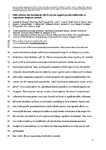Little evidence that lowering the pH of concrete supports greater biodiversity on tropical and temperate seawalls
| dc.contributor.author | Hsiung, AR | |
| dc.contributor.author | Tan, WT | |
| dc.contributor.author | Loke, LHL | |
| dc.contributor.author | Firth, LB | |
| dc.contributor.author | Heery, EC | |
| dc.contributor.author | Ducker, J | |
| dc.contributor.author | Clark, V | |
| dc.contributor.author | Pek, YS | |
| dc.contributor.author | Birch, WR | |
| dc.contributor.author | Ang, ACF | |
| dc.contributor.author | Hartanto, RS | |
| dc.contributor.author | Chai, TMF | |
| dc.contributor.author | Todd, PA | |
| dc.date.accessioned | 2021-02-04T10:13:50Z | |
| dc.date.available | 2021-02-04T10:13:50Z | |
| dc.date.issued | 2020-12-10 | |
| dc.identifier.issn | 0171-8630 | |
| dc.identifier.issn | 1616-1599 | |
| dc.identifier.uri | http://hdl.handle.net/10026.1/16843 | |
| dc.description.abstract |
<jats:p>Concrete is one of the most commonly used materials in the construction of coastal and marine infrastructure despite the well known environmental impacts which include a high carbon footprint and high alkalinity (~pH 13). There is an ongoing discussion regarding the potential positive effects of lowered concrete pH on benthic biodiversity, but this has not been investigated rigorously. Here, we designed a manipulative field experiment to test whether carbonated (lowered pH) concrete substrates support greater species richness and abundance, and/or alter community composition, in both temperate and tropical intertidal habitats. We constructed 192 experimental concrete tiles, half of which were carbonated to a lower surface pH of 7-8 (vs. control pH of >9), and affixed them to seawalls in the United Kingdom and Singapore. There were 2 sites per country, and 6 replicate tiles of each treatment were collected at 4 time points over a year. Overall, we found no significant effect of lowered pH on the abundance, richness, or community assemblage in both countries. Separate site- and month-specific generalised linear models (GLMs) showed only sporadic effects: i.e. lowered pH tiles had a small positive effect on early benthic colonisation in the tropics but this was later succeeded by similar species assemblages regardless of treatment. Thus, while it is worth considering the modification of concrete from an environmental/emissions standpoint, lowered pH may not be a suitable technique for enhancing biodiversity in the marine built environment.</jats:p> | |
| dc.format.extent | 193-205 | |
| dc.language | en | |
| dc.language.iso | en | |
| dc.publisher | Inter Research | |
| dc.subject | Coastal defences | |
| dc.subject | Concrete carbonation | |
| dc.subject | Eco-engineering | |
| dc.subject | Materials | |
| dc.subject | pH | |
| dc.subject | Biodiversity | |
| dc.subject | Concrete | |
| dc.title | Little evidence that lowering the pH of concrete supports greater biodiversity on tropical and temperate seawalls | |
| dc.type | journal-article | |
| dc.type | Article | |
| plymouth.author-url | https://www.webofscience.com/api/gateway?GWVersion=2&SrcApp=PARTNER_APP&SrcAuth=LinksAMR&KeyUT=WOS:000621252600015&DestLinkType=FullRecord&DestApp=ALL_WOS&UsrCustomerID=11bb513d99f797142bcfeffcc58ea008 | |
| plymouth.volume | 656 | |
| plymouth.publication-status | Published | |
| plymouth.journal | Marine Ecology: Progress Series | |
| dc.identifier.doi | 10.3354/meps13365 | |
| plymouth.organisational-group | /Plymouth | |
| plymouth.organisational-group | /Plymouth/Faculty of Science and Engineering | |
| plymouth.organisational-group | /Plymouth/Faculty of Science and Engineering/School of Biological and Marine Sciences | |
| plymouth.organisational-group | /Plymouth/REF 2021 Researchers by UoA | |
| plymouth.organisational-group | /Plymouth/REF 2021 Researchers by UoA/UoA07 Earth Systems and Environmental Sciences | |
| plymouth.organisational-group | /Plymouth/Users by role | |
| plymouth.organisational-group | /Plymouth/Users by role/Academics | |
| dcterms.dateAccepted | 2020-05-11 | |
| dc.rights.embargodate | 2021-2-6 | |
| dc.identifier.eissn | 1616-1599 | |
| dc.rights.embargoperiod | Not known | |
| rioxxterms.versionofrecord | 10.3354/meps13365 | |
| rioxxterms.licenseref.uri | http://www.rioxx.net/licenses/all-rights-reserved | |
| rioxxterms.licenseref.startdate | 2020-12-10 | |
| rioxxterms.type | Journal Article/Review |


